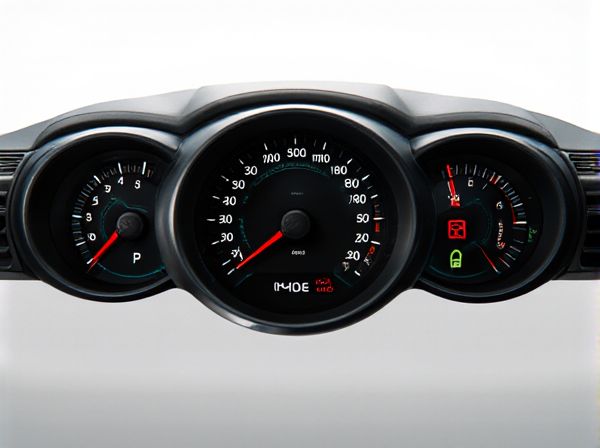
Photo illustration: Oil Pressure Warning vs Battery Charge Warning
The oil pressure warning light indicates a problem with the engine's lubrication system, signaling that oil levels are low or the oil pump is failing, which can cause severe engine damage if ignored. The battery charge warning light alerts you to an issue with the vehicle's charging system, meaning the battery is not receiving enough power, potentially leading to a dead battery and electrical failures. Understanding these warnings helps you address critical mechanical or electrical problems promptly, ensuring your car runs smoothly and safely.
Table of Comparison
| Feature | Oil Pressure Warning | Battery Charge Warning |
|---|---|---|
| Purpose | Indicates low engine oil pressure | Signals battery charging system issue |
| Common Cause | Low oil level or faulty oil pump | Alternator failure or broken drive belt |
| Icon | Oil can symbol | Battery symbol |
| Risk | Engine damage from inadequate lubrication | Vehicle may lose electrical power, stalling risk |
| Immediate Action | Stop engine and check oil level | Check alternator belt and battery connections |
| Severity | High - critical engine protection | Medium - electrical system warning |
Introduction to Dashboard Warning Lights
Oil pressure warning lights indicate low oil pressure in the engine, signaling potential lubrication failure that can cause severe engine damage. Battery charge warning lights alert drivers to issues with the vehicle's charging system, such as a failing alternator or battery, which can lead to electrical system failure. Both dashboard warning lights are critical for vehicle safety and require immediate attention to prevent costly repairs.
What is an Oil Pressure Warning Light?
An oil pressure warning light indicates low oil pressure in the engine, which can lead to severe engine damage if not addressed promptly. This light signals that the oil pump is failing to circulate enough oil for proper lubrication, risking overheating and increased friction between engine components. Unlike the battery charge warning light that shows charging system issues, the oil pressure warning is critical for maintaining engine health and preventing costly repairs.
What is a Battery Charge Warning Light?
The battery charge warning light indicates a problem with the vehicle's charging system, often signaling that the alternator is not generating enough electrical power to recharge the battery. This warning light appears on the dashboard to alert drivers that the battery may soon lose its charge, which can lead to engine stalling or electrical system failure. Unlike the oil pressure warning light, which signals low engine oil pressure, the battery charge warning light specifically relates to the electrical system's inability to maintain adequate battery voltage.
Common Causes of Oil Pressure Warnings
Oil pressure warnings commonly arise from low oil levels, a faulty oil pump, or clogged oil filters, which impede proper lubrication and engine performance. In contrast, battery charge warnings typically indicate alternator failure, battery deterioration, or loose wiring affecting electrical system functioning. Recognizing these distinct causes helps prevent engine damage from oil pressure issues and electrical failures related to battery charge warnings.
Common Causes of Battery Charge Warnings
Battery charge warnings commonly result from a failing alternator, loose or corroded battery terminals, or a defective voltage regulator, all of which disrupt the vehicle's electrical system. A weakened or dead battery often triggers the warning light, signaling inadequate power supply to start the engine or operate accessories. Unlike oil pressure warnings that indicate lubrication issues, battery charge warnings focus specifically on electrical charging system malfunctions.
Signs and Symptoms: Oil Pressure vs Battery Charge Issues
Oil pressure warning signs include a ticking engine noise, engine overheating, and a dashboard light shaped like an oil can or gauge showing low oil pressure. Battery charge warning symptoms often involve dim headlights, slow engine crank, and a battery icon or charging system light illuminating on the dashboard. Distinguishing between low oil pressure and battery charge issues requires monitoring specific indicators like oil level and voltage readings to prevent engine damage or electrical failure.
Immediate Actions When Oil Pressure Light Activates
When the oil pressure warning light activates, immediately stop the vehicle to prevent engine damage caused by inadequate lubrication. Check the oil level using the dipstick and top up if low, but avoid driving until normal oil pressure is restored to prevent severe engine wear or failure. In contrast, the battery charge warning light indicates an issue with the charging system, allowing for limited driving while seeking prompt service to address alternator or battery problems.
Immediate Actions When Battery Charge Light Activates
When the battery charge warning light activates, immediately check the alternator belt for tension and wear, as a slipping or broken belt can prevent proper charging. Turn off non-essential electrical loads such as the radio, air conditioning, and heated seats to conserve battery power. Seek professional assistance promptly to avoid a drained battery that could leave the vehicle stranded.
Long-Term Risks of Ignoring Each Warning
Ignoring the oil pressure warning can lead to severe engine damage due to insufficient lubrication, causing overheating, increased wear, and potential engine failure over time. Neglecting the battery charge warning risks battery depletion, resulting in electrical system failures, inability to start the vehicle, and long-term alternator damage. Both warnings indicate critical system malfunctions that require prompt attention to avoid costly repairs and compromised vehicle safety.
Preventive Maintenance for Oil Pressure and Battery Systems
Oil pressure warning signals indicate potential engine lubrication issues, necessitating immediate oil level and pump inspections to prevent damage and ensure efficient performance. Battery charge warning highlights charging system failures, requiring regular alternator checks and battery maintenance to avoid unexpected power loss. Preventive maintenance focused on timely oil changes, system diagnostics, and battery health assessments significantly reduces the risk of breakdowns and extends vehicle lifespan.
 caratoz.com
caratoz.com